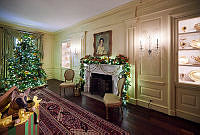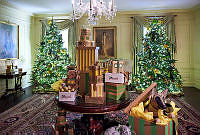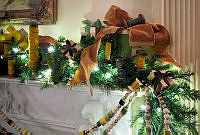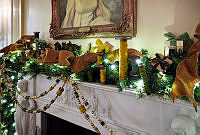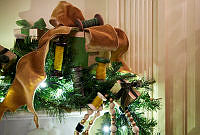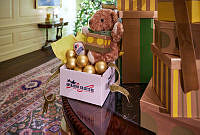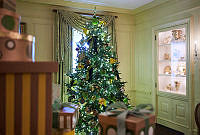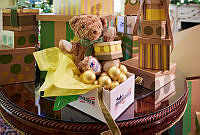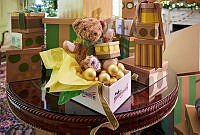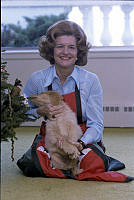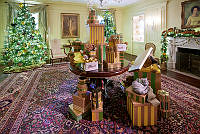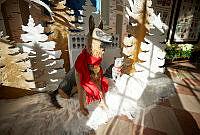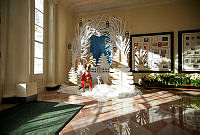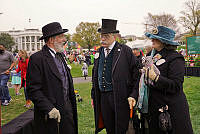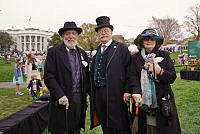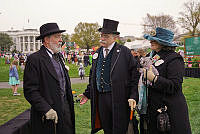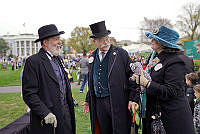Rubenstein Center Scholarship
Here Kitty Kitty
A Brief History of White House Cats
First families have welcomed pets to the White House since its earliest occupants assumed residency. Dogs have been the most prevalent presidential pet in American history. However, in recent years, cats have become more frequent occupants of 1600 Pennsylvania Avenue.
The increased feline occupancy of the White House in the past fifty years is likely a reflection of cats becoming a more common household pet in the United States. The White House is a symbol of American democracy, a home for the first family, and an office for the president. It also serves as a national stage, mirroring American popular culture, societal norms, and household practices. Earlier statistics of cat ownership are not readily available, but one study estimated that 30.5% of American homes included a cat in 1986.1 This percentage held steady for several decades; in 2001, 31.6% of U.S. households included a cat.2 However, cats as pets grew in aggregate numbers, since households were more likely to own multiple cats. Furthermore, a higher percentage of Americans became cat owners in the past twenty years. Now, a cat-owning household averages about two cats, with 35.7% of American homes with cats as pets.3 According to a survey, the COVID-19 pandemic greatly increased pet ownership, with 9% of American households acquiring one or more cats since its inception.4

This photograph of President Bill Clinton with the Clintons' family cat Socks was taken in 1993. Clinton and Socks are on the South Grounds of the White House.
William J. Clinton Presidential Library and Museum/NARACats were occasional presidential pets during the nineteenth and early twentieth century. Abraham Lincoln enjoyed the company of cats. His wife, Mary Lincoln, stated that Lincoln’s hobby was “cats.”5 Lincoln left his dog Fido at home in Springfield, Illinois, after winning the presidency, which paved the way for Secretary of State William Seward to give Lincoln two cats named Tabby and Dixie. They are believed to be the first cats to live at the White House. Lincoln allegedly remarked that Dixie was smarter than members of his cabinet and pleased him more. Dixie, according to Lincoln, didn’t talk back.6 However delightful, the quote is likely apocryphal, since the quote is not well documented by a primary source.
In 1878, the American consul in Bangkok, David Sickels, gifted a rare Siamese cat to President Rutherford B. Hayes and First Lady Lucy Hayes. Sickels had learned that Mrs. Hayes liked cats, and Siam became the first Siamese cat in the United States.7 The cat arrived in early 1879 and became the pet of daughter Fanny Hays.8 Unfortunately, the cat became ill nine months after its arrival. The president’s personal physician attempted to help the cat, but she died at the White House.9 A taxidermist was notified to preserve Siam, but no record exists about where the kitty finally ended up.10

President Theodore Roosevelt encounters Slippers the cat while walking along the Cross Hall at the White House during a diplomatic dinner in 1906.
Internet Archive/University of North Carolina at Chapel HillTheodore Roosevelt and his family shared the White House with a menagerie of pets, including a six-toed tabby cat named Slippers. This type of cat is known as a polydactyl, derived from the Greek word meaning “many fingers.” Polydactyls are known for their excellent climbing and hunting skills.11 A humorous second-hand story about Slippers is worth mentioning. At a January 11, 1906, diplomatic corps dinner, President Roosevelt escorted the wife of the Hungarian ambassador, Baroness Hengenmuller, along the Cross Hall from the East Room to the State Dining Room. To everyone’s surprise, Slippers had decided to take a nap on the comfy carpet of the Cross Hall. Roosevelt merely walked around his feline pal and let her continue to snooze.12 The source of this amusing anecdote was famous journalist Jacob Riis, who wrote a 1908 article in a children’s magazine about the famous polydactyl titled “Slippers, the White House Cat.”13
Calvin Coolidge was another early twentieth century president fond of cats. Coolidge liked to wear Tige (short for Tiger) around his neck. Unfortunately, Tige had a taste for wanderlust and liked to roam away from the White House. His disappearance was reported by the local media, and Tige was returned, at least once, back to the White House.14 Blacky, another Coolidge cat, spent less time inside the White House since he preferred the outdoors. Since he liked to eat, Blacky’s favorite room in the White House was the kitchen, where he often roamed in search of a handout.15

This photograph of Amy Carter, daughter of President Jimmy Carter, with her Siamese cat Misty Malarky Ying Yang was taken by Charles Rafshoon on August 15, 1977.
Jimmy Carter Presidential Library and Museum/NARARecent presidents have welcomed cats to the White House with higher frequency. Susan Ford, the daughter of President Gerald Ford and First Lady Betty Ford, brought her Siamese cat Shan to the White House in 1974. In addition to Susan, Shan also liked spending time with First Lady Betty Ford, often relaxing with her during the day at the White House. Documents at the Gerald R. Ford Presidential Library demonstrate there was significant media interest in Shan, with frequent press solicitations for information and even book proposals about his life at the White House.16
Likewise, Misty Malarky Ying Yang, the Siamese cat of first daughter Amy Carter, also generated considerable attention. Guitarist Gabor Szabo composed a jazz song called “Misty Malarky Ying Yang,” which he included on his 1977 album, Faces.17 In 1977, Misty Malarky made headlines when he wandered down the Grand Staircase at the White House during a State Dinner. A social aide directed the cat back up the stairs, where he passed President Carter and Mexican President Jose Portillo as they made their grand entrance.18
No cat in White House history has received as much attention as Socks, owned by first daughter Chelsea Clinton. Socks was a stray tuxedo cat adopted by the Clintons in Arkansas. He was named for his white paws, which gave the appearance he was wearing socks. Socks became a pop culture icon during his tenure at the White House. A perennial favorite of the press, he was often photographed at the White House, including behind the podium of the press room. Several books were written about him, he had his own fan club, and he was the subject of a “Murphy Brown” television episode. Numerous obituaries detailed Socks’ biography when he passed away in 2009, with the Los Angeles Times stating that Socks had lived a “Horatio Alger life.”19

In this photograph, the pets of President George W. Bush and First Lady Laura Bush pose for a Halloween portrait on the South Lawn of the White House. Pictured in this photograph are India, their cat, and Miss Beazley and Barney, their two Scottish Terriers. The South Portico can be seen in the background.
George W. Bush Presidential Library and Museum/NARAGeorge W. Bush and Laura Bush brought a black Shorthair cat named India to the White House. India did not receive as much media attention as Barney and Miss Beazley, the two Scottish terriers who also lived at the White House. However, India (also known occasionally as “Willie”) did appear in BarneyCam videos at the holidays.20 Also, India made a notable Halloween appearance on the White House South Lawn in 2007, dressed as a wizard.21
In January 2022, the White House announced that a gray tabby cat, Willow, would join the Biden family. First Lady Dr. Jill Biden first encountered the cat during a 2020 campaign stop in Pennsylvania. The cat interrupted Dr. Biden’s speech, and the owner of the farm agreed to let the Bidens adopt Willow. The cat is named after Dr. Biden’s hometown of Willow Grove, Pennsylvania. Willow became the first cat to live in the White House more than ten years.22

In January 2022, the Bidens adopted a gray shorthair tabby cat named Willow. The photo is an Official White House photograph by Erin Scott.
Official White House PhotoDespite the more recent popularity of felines in the White House, there is no doubt that dogs residing in the White House historically outnumber cats. This is likely a consequence of the greater number of pet dogs in the United States (almost 77 million) versus pet cats (58 million).23 However, there may be other reasons for the relative popularity of “first dogs” vis-à-vis “first cats.” Experts have weighed in on the matter. Mental health professionals have concluded that dogs are viewed as “loyal” companions while cats are often described as “independent.” First families may prize the depiction of loyalty as a more valuable attribute. Furthermore, other experts stated that dogs are viewed as more “macho” than cats, given their penchant to participate in hunting and other outdoor activities. This may be more suitable for presidents who want to display masculine leadership qualities. Lastly, political consultants emphasized a more pragmatic concern. It is more difficult to get cats to pose for photos while dogs are much more amenable. From a public relations perspective, politicians may find it more beneficial to own dogs than cats.24
Even though dogs have historically maintained the upper paw at the White House, cats have come on strong in recent decades, perhaps even challenging the previously foregone conclusion that dogs are the unquestioned “first pet” of the United States. Like the Bidens, future first families may reside with both cats and dogs, which may indeed prove to be the purr-fect combination for the White House.





